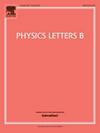Deflection angle of regular black holes in nonlinear electrodynamics: Gauss-Bonnet theorem, time delay, shadow, and greybody bound
IF 4.5
2区 物理与天体物理
Q1 ASTRONOMY & ASTROPHYSICS
引用次数: 0
Abstract
In this article, we study the weak gravitational lensing in the background of regular, static, spherically symmetric black hole solutions of Einstein’s standard general relativity coupled with nonlinear electrodynamics. The weak deflection angles are estimated in the context of vacuum medium and plasma medium using the Gauss-Bonnet method. The obtained deflection angles decrease as the impact parameter and the charge parameter increase, while the deflection angles increase gradually with increasing values of the black hole mass . Moreover, the effect of a plasma medium has increased the deflection angle than the vacuum medium scenario. We also estimate the time delay in the field of the described black holes that vanishes for , i.e., the absence of the black holes. The shadow cast of the present black holes is also analyzed with respect to the impact and mass , which ensures that the shadow region shrinks for increasing values of and expands for increasing values of . In addition, we estimated the rigorous bounds of the greybody factor for the described black holes and the graphical analysis ensures that the increasing charge parameter decreases the rigorous bound of and the increasing mass increases the rigorous bound of .
非线性电动力学中规则黑洞的偏转角:高斯-博内定理、时间延迟、阴影和灰体界
本文研究了爱因斯坦标准广义相对论正则、静态、球对称黑洞解与非线性电动力学耦合背景下的弱引力透镜效应。利用高斯-邦纳方法估计了真空介质和等离子体介质的弱偏转角。得到的偏转角随冲击参数b和电荷参数q的增大而减小,随黑洞质量m的增大而逐渐增大,且等离子体介质的作用比真空介质的作用更增大了偏转角。我们还估计了所描述的黑洞场中的时间延迟,该延迟在m=q=0时消失,即不存在黑洞。阴影的黑洞也分析了关于q和质量的影响,从而确保阴影区增加萎缩的q值和扩展的m值增加。此外,我们估计的严格界限greybody因素结核病的描述黑洞和图形分析确保增加电荷参数q减少结核病的严格约束,增加质量增加结核病的严格约束。
本文章由计算机程序翻译,如有差异,请以英文原文为准。
求助全文
约1分钟内获得全文
求助全文
来源期刊

Physics Letters B
物理-物理:综合
CiteScore
9.10
自引率
6.80%
发文量
647
审稿时长
3 months
期刊介绍:
Physics Letters B ensures the rapid publication of important new results in particle physics, nuclear physics and cosmology. Specialized editors are responsible for contributions in experimental nuclear physics, theoretical nuclear physics, experimental high-energy physics, theoretical high-energy physics, and astrophysics.
 求助内容:
求助内容: 应助结果提醒方式:
应助结果提醒方式:


